Australia boasts a rich diversity of birdlife, with over 800 species found across the continent and its surrounding islands and territories. From the majestic Wedge-tailed Eagle to the iconic Emu, Australian birds offer a stunning display of physical beauty, unique behaviours and cultural significance.
Australian birds are known for their unique physical characteristics that set them apart from other bird species around the world. One of the most notable features of many Australian birds is their striking colouration, seen in the parrots and cockatoos but also in other groups such as kingfishers, pigeons and fruit-doves. From the vibrantly coloured feathers of the Rainbow Lorikeet or the Wompoo Fruit-dove to the distinctive pink and grey plumage of the Galah, Australian birds offer a visual feast for bird watchers.
Many Australian birds have evolved special adaptations to suit their particular environments, such as the long, curved beaks and brushed tongues of the Australian honeyeaters that allow them to extract nectar from eucalypt flowers or the long, black shaggy feathers of the Southern Cassowary that help keep the bird cool and also hidden when searching for food in the dark rainforest understorey webbed feet of water birds that help them swim and hunt in wetlands. Australian birds are also renowned for their unique behaviours, such as the Superb Lyrebird’s ability to mimic a wide variety of sounds or the Satin Bowerbird’s elaborate decorations and placement of bright blue coloured objects surrounding his bower.
Delve into the fascinating world of Australian birds and learn about their physical characteristics, habitat, behaviour and the important role they play in Australian culture.
Scientific name: Tyto alba
The nocturnal Barn Owl is one of the most widespread owl species in Australia. These birds of prey are known for their distinctive heart-shaped faces and ability to hunt prey at night. Specialised feathers around their face and ear openings channel sound into the ears enabling them to locate prey in the dark by sound. Barn Owls primarily feed on small mammals, mostly introduced mice and rodents that are attracted to grains and other crops, making them an important predator in many ecosystems and farmland areas.
Despite their significant role in the food chain, Barn Owls in Australia are impacted by habitat loss and degradation, as well as other factors including vehicle strikes and poisoning. Conservation efforts such as reducing the clearing of natural forested habitat and the reduction of pesticide use, can help to protect the Barn Owl population in Australia.
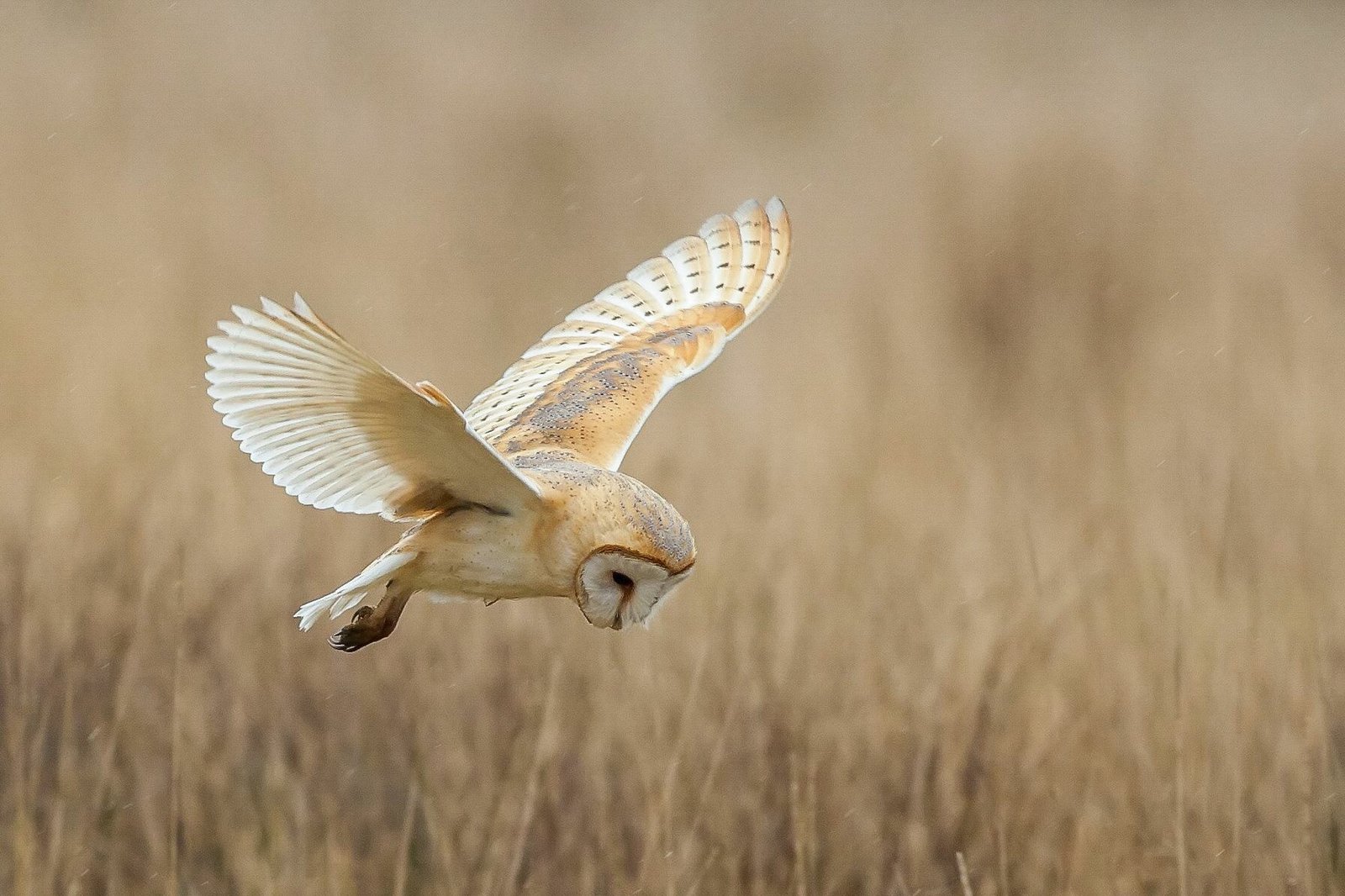
Three unique facts about the Barn Owl:
- Unique behaviour: Barn Owls have unique adaptations (specialised feathers, keen eyesight) that enable them to hunt mice and rodents at night.
- Breeding: In Australia the Barn Owl opportunistically breeds throughout the year, with peaks in the breeding season during spring, or in response to availability of food. They nest in hollow trees, abandoned buildings and man-made structures such as nest boxes. Females lay 3-6 eggs, and both parents share incubation and feeding duties until the chicks fledge at around 50-55 days old.
- Vocalisations: Barn Owls are known for their distinctive screeching call, which can be heard at night and during the breeding season. In Australia, their calls are often described as sounding like a rasping, hissing scream or a loud, eerie trill.
Learn more about the Barn Owl.
Scientific name: Cygnus atratus
The Black Swan is an iconic and beloved bird of Australia, known for its striking appearance with its black feathers, bright red beak and long neck. Black Swans are found throughout Australia, often in wetlands and waterways and feed on aquatic plants and other invertebrates.
Black Swans have also played an important role in Australian culture, featuring in First Nations stories and is the offical state emblem of Western Australia. While Black Swan populations are currently stable, threats such as habitat loss and pollution remain a concern. These majestic birds are an important part of Australia’s natural heritage and are treasured by many.
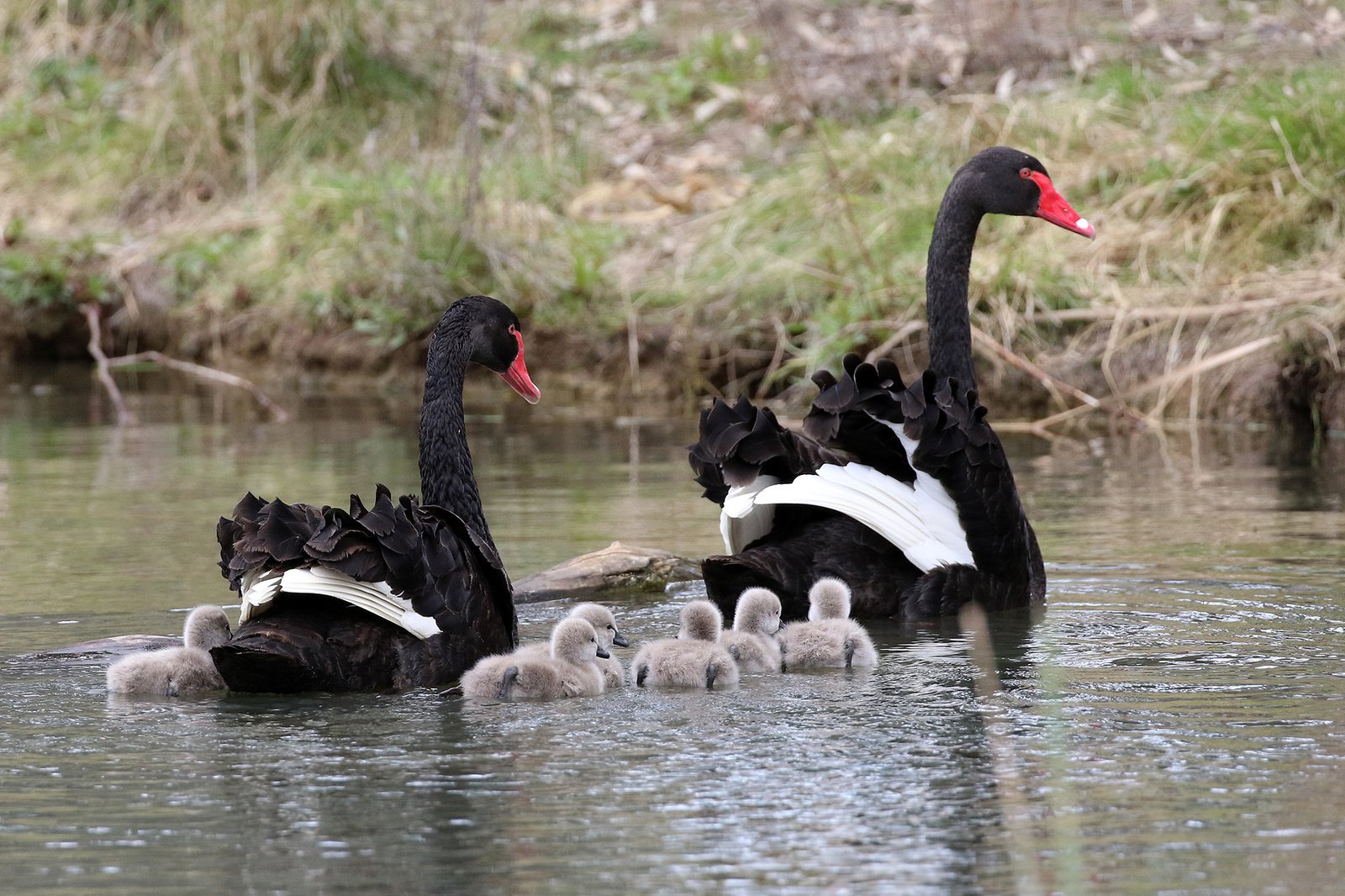
Three unique facts about the Black Swan:
- Unique to Australia: Black Swans are native to Australia and are the only species of swan that is almost entirely black. They are found across the country in wetlands, lakes and rivers and have become an iconic symbol of Australian wildlife.
- Monogamous bond: Black swans are monogamous birds and pair for life. They form strong bonds with their mate and will fiercely defend their territory and offspring.
- Ability to fly long distances: Despite their large size and weight, Black Swans are strong fliers and can cover long distances when they migrate. They often fly in large flocks and can be seen flying in a v-formation
Learn more about the Black Swan.
Scientific name: Dromaius novaehollandiae
The Emu is a large, flightless bird native to Australia. They are the tallest bird in Australia and can grow up 2 meters and weigh up to 60 kilograms.
Known for their distinctive appearance, Emus can be identified by their long, slender necks, small heads and long, shaggy brown feathers that cover their bodies. They have powerful legs that are well-adapted for running and can reach speeds approaching 50 kilometres per hour.
These birds are also highly adaptable and can survive in a range of different habitats, from open grasslands and forests to deserts and coastal regions. They are omnivorous and have a varied diet including insects, fruits, grasses and seeds.
Emus are generally solitary animals but will come together in pairs or small groups during the breeding season. Females are the dominant sex and will typically lay a clutch of 5-15 eggs which the male then incubates for around 8 weeks until they hatch.
The Emu has evolved to thrive in a variety of environments and remains an iconic symbol of Australia and wildlife. It is featured on the Australian Coat of Arms.
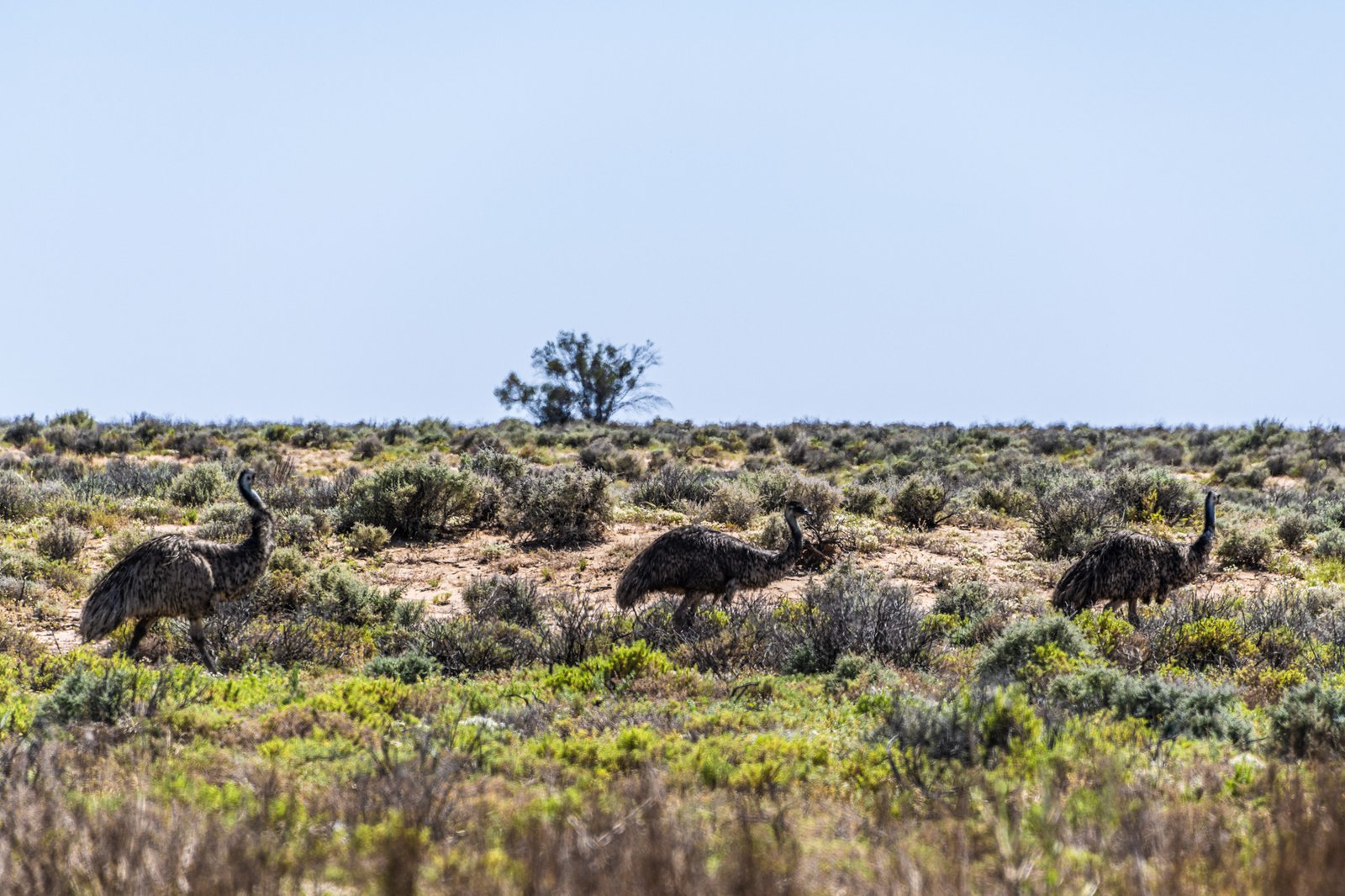
- Tallest Australian bird: Emus are the tallest Australian bird species, reaching heights of nearly 2 metres.
- Unique feathers: Emus have unique feathers that are long and shaggy, providing insulation qualities that help regulate body temperature in diverse weather conditions.
- Fast Runners: They are flightless birds and use their strong legs to run at a speed of up to 50 kilometres per hour.
Learn more about the Emu.
Scientific name: Dacelo novaeguineae
The Laughing Kookaburra is native to Australia, most well-known for its distinctive call that sounds like chuckling or laughter. They are immediately recognisable as they are the largest kingfisher in Australia. They have dark brown wings with white chest and belly, a large head with a dark eye band and a large, powerful beak.
Laughing Kookaburras belong to the Kingfisher family and the species has an entirely carnivorous diet. Laughing Kookaburras mainly feed on insects, small reptiles and rodents. A characteristic hunting behaviour of the species is to swoop down and carry off larger prey to a nearby perch where it will beat it against the branch before swallowing whole.
Along the east coast of Australia, the Laughing Kookaburra can be found close to urban areas, in city parklands and gardens and because of this the species is more readily seen by people. Their distinct appearance, unique hunting behaviours and recognisable calls make them an iconic Australian species.
Three unique facts about the Laughing Kookaburra:
- Distinctive call: Laughing Kookaburras have a distinctive call that sounds like human laughter.
- Unique hunting behaviour: Laughing Kookaburras are known for their to swoop down to catch prey such as snakes, lizards and small mammals using their powerful beaks hold prey and beat it against a perch.
- Adaptability to different environments: Laughing Kookaburras are able to adapt to different environments and are found in a variety of habitats, including forests, woodland and urban areas.
Learn more about the Laughing Kookaburra.
Scientific name: Psephotellus pulcherrimus
The Paradise Parrot was a beautiful bird species native to Australia that is now extinct. With its bright green and yellow plumage and distinctive long tail, it was once one of the most striking bird species in the country. The species was highly dependent on the grassy woodlands of eastern Australia and habitat destruction and hunting led to its extinction in the early 20th century.
Despite some unconfirmed sightings, the species is believed to be extinct and its loss serves as a reminder of the importance of conservation efforts to protect endangered species. Studying the history and biology of the Paradise Parrot can help us to understand the tragic consequences of habitat destruction and inspire us to protect the remaining wildlife in Australia and beyond.
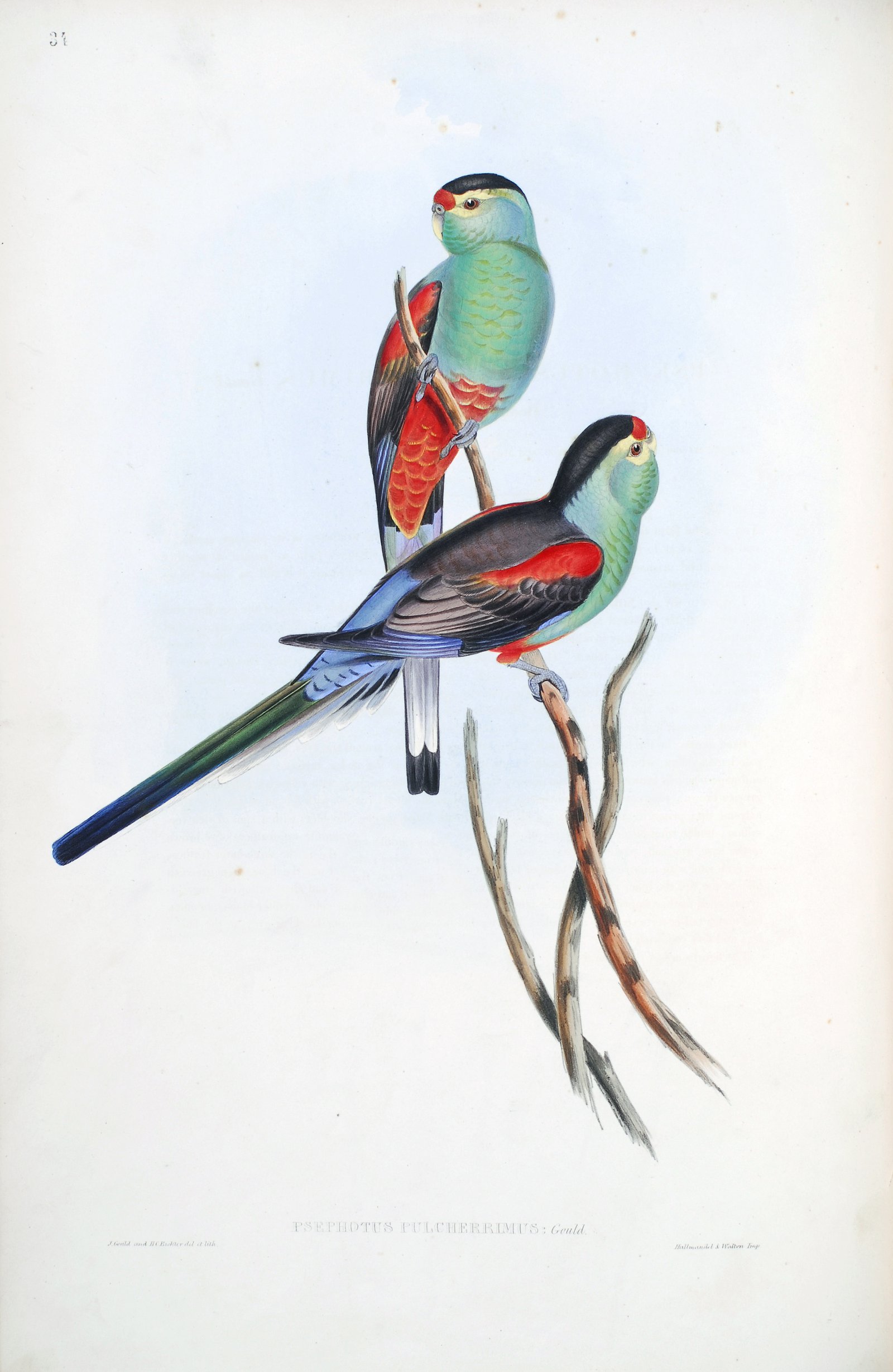
Three unique facts about the extinct Paradise Parrot:
- Habitat: The Paradise Parrot (Psephotus pulcherrimus) was a beautiful bird that once lived in Australia’s grasslands and savannas. It was found across the eastern and southeastern parts of the continent, including Queensland, New South Wales, Victoria and South Australia.
- Extinction: The species became extinct in the early 20th century due to a combination of factors, including habitat destruction, hunting and introduced predators such as foxes and feral cats. The last confirmed sighting of the bird was in Queensland in 1927.
- Physical characteristics: The Paradise Parrot was a small parrot, measuring around 23-25 centimeters in length. The males had bright green plumage with a blue crown, yellow cheeks and a red band on their breast. Females had less vibrant plumage, with a green head and back and a yellowish-green underbelly. The species was also known for its distinctive call, which was described as a high-pitched, metallic chattering sound.
Scientific name: Cracticus nigrogularis
The Pied Butcherbird is a common and easily recognisable species found throughout Australia, and has an impressive melodious song repertoire that can be heard throughout the day, and often at dawn. With its distinct black and white plumage, the Pied Butcherbird has been given this common name based on both its appearance and gruesome feeding behaviour, which involves impaling their prey such as insects, lizards, and small mammals on thorns or spikes to make it easier to consume. The species also has a small hook at the tip of the upper bill which is used to hold and hook into flesh during feeding.

Pied Butcherbirds are non-migratory and prefer to stay in one area year-round. Despite their relative abundance, Pied Butcherbirds are declining in some areas owing to habitat loss from urban expansion, making conservation efforts important to maintain their populations.
The Pied Butcherbird is classified as a songbird, and is in the same family as the well-known and closely related Australian Magpie.
Three unique facts about the Pied Butcherbird:
- Unique behaviour: The Pied Butcherbird has a unique feeding behaviour where it impales its prey on thorns or spikes to make it easier to consume.
- Complex vocalisations: The Pied Butcherbird is known for its melodious and complex vocalisations, consisting of a wide range of notes and tones, often used to communicate with its mate or defend its territory.
- Cooperative breeding: Pied Butcherbirds often engage in cooperative breeding, where the offspring from previous years help their parents raise the new chicks.
Learn more about the Pied Butcherbird.
Scientific name: Calyptorhynchus banksii
The Red-tailed Black-Cockatoo is a bird species endemic to Australia. The Red-tailed Black-Cockatoo is identifiable by its distinctive black feathers and bright red band on the underside of the tail in male birds. Female birds have orange-red barring on the underside of the tail. They prefer to live in woodland habitats and feed on the nuts and woody fruits of selected tree species including Pandanus and Eucalyptus.
The South-Eastern Red-tailed Black Cockatoo subspecies is is considered endangered due to habitat loss of old growth forests and conservation efforts are being made to protect their habitats. They are a long-lived species and usually lay a single egg in old growth tree hollows which they rely on for breeding success.
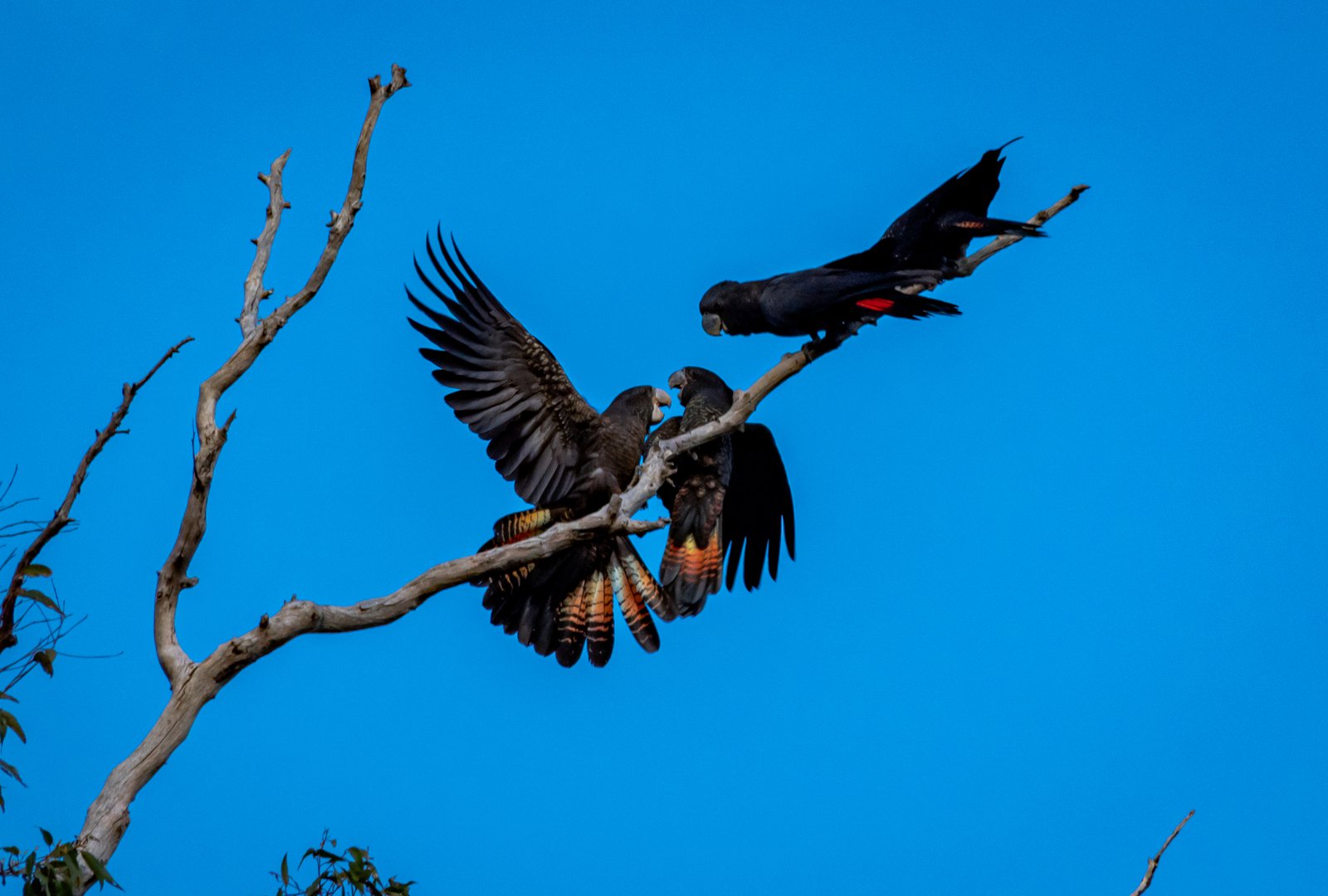
Three unique facts about the Red-tailed Black-Cockatoo:
- Distinctive appearance: The Red-tailed Black-Cockatoo is identifiable by its distinctive appearance. It is a large, black cockatoo species with black feathers and a large red band on the underside of the tail (male birds), making it one of the most visually striking bird species in Australia.
- Unique behaviour: Red-tailed Black-Cockatoos has a specialised diet of nuts and fruits from selected tree species. They use their powerful beaks to crack open the nuts and woody fruits.
- Threatened species: The South-Eastern Red-tailed Black-Cockatoo subspecies is considered an endangered species due to habitat loss and degradation.
Learn more about the Red-tailed Black-Cockatoo.
Scientific name: Anthochaera phrygia
The Regent Honeyeater is a Critically Endangered bird species native to southeastern Australia, and is especially dependent on dry sclerophyll woodland and nectar producing Eucalypt species. It is identifiable by its distinctive black and yellow chevrons on the chest and is known for its melodious singing. It can also mimic the calls of other locally occurring birds, including other honeyeaters. The thickened fleshy skin around the eyes gave the appearance of warts, such that an earlier name for the bird was “Warty-faced Honeyeater”!
The species has a limited distribution across its known range and has suffered greatly due to habitat loss and fragmentation. Conservation efforts are being made to restore their habitats and protect the remaining populations of Regent Honeyeaters. Through these efforts, it is hoped that the species will recover and thrive once again. Understanding the Regent Honeyeater’s unique characteristics and conservation needs is critical to the survival of this species.
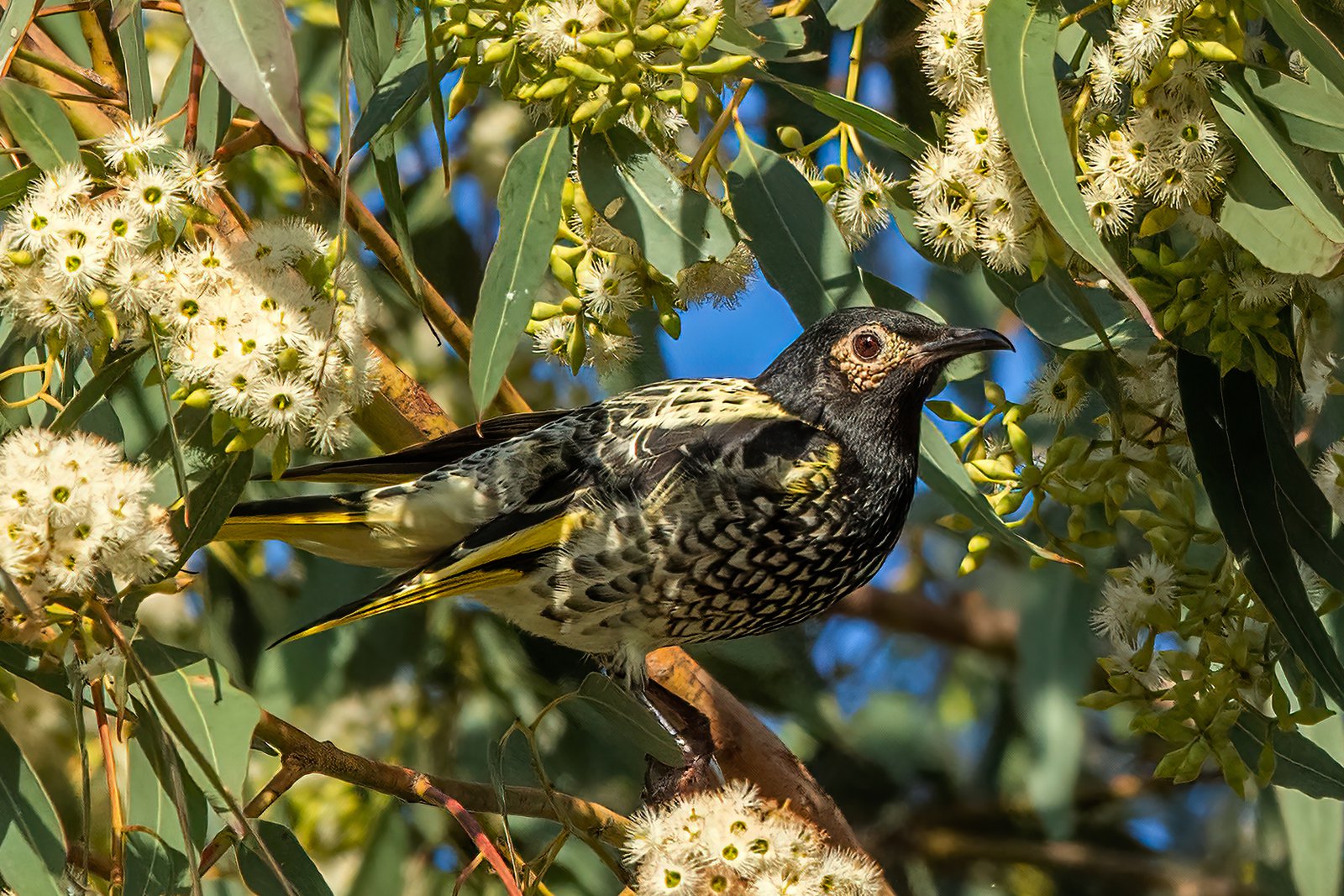
Three unique facts about the Regent Honeyeater:
- Distinctive appearance: The Regent Honeyeater is identifiable by its distinctive black and yellow markings over much of its body and wings. It has a black head and throat, with a bright yellow belly, black and pale yellow chevrons on the chest, and distinctive yellow patches on its wings.
- Melodious song: The Regent Honeyeater is known for its melodious singing, which is often compared to that of a bellbird. They can also mimic the calls of other birds, including honeyeaters.
- Critically endangered species: The Regent Honeyeater is a critically endangered bird species due to habitat loss. It is highly dependent on nectar from eucalyptus tree. Conservation efforts are being made to restore their habitats and protect the remaining populations of Regent Honeyeaters, with the hope of saving this unique bird species from extinction.
Learn more about the Regent Honeyeater.
Scientific name: Aquila audax
The Wedge-tailed Eagle is Australia’s largest bird of prey and a symbol of strength and power. With a wingspan of more than 2 meters, and weighing up to 5 kilograms, these majestic birds are a formidable presence in the skies. Females are larger than males, and the plumage of the birds darkens as they age.
They are found throughout mainland Australia and are known for their keen eyesight and hunting prowess, soaring to great heights using thermal air currents and spotting prey over large distances. Wedge-tailed Eagles feed on a range of prey including rabbits, kangaroos and even snakes. They are also scavengers, often feeding on roadkill and carrion. In doing so, these birds play an important role in Australia’s ecosystem as they clean up the decomposing carcasses. Despite their size and strength, Wedge-tailed Eagles face threats from habitat loss, illegal poisoning and collisions with vehicles.

Three unique facts about the Wedge-tailed Eagle:
- Distinctive appearance: The Wedge-tailed Eagle is the largest bird of prey in Australia, with a wingspan of over 2 meters and weighing up to 5 kg.
- Unique behaviour: Wedge-tailed Eagles are specialist scavengers and can soar to great heights using thermal air currents, using their keen eyesight to search for prey.
- Long-lived species: Wedge-tailed Eagles reach breeding age at around 3 years of age but will usually not breed until they are atleast 7 years of age. This slow rate of reproduction means that populations are vulnerable to habitat loss and other threats.





